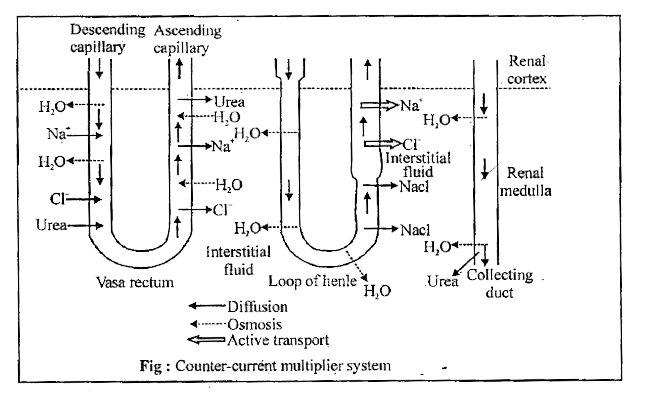Describe the counter-current mechanism.
Text Solution
Counter-current mechanism :
The movement of fluids in opposite directions is called counter current. It is useful in making the urine hypertonic. In this mechanism, water is conserved to maintain osmoregulation. There are two counter current mechanisms in nephrons :
I) Glomerulus filterate flows from cortex to medulla region in descending limbs and medulla to cortex region in ascending limb.
II) Blood flows in vasa recta toward renal medulla in descending capillary and towards the renal cortex in ascending capillary.
These mechanisms involves the following parts of nephron :
i) the loops of Henle
ii) the vasa recta
iii) collecting tubule and collecting duct.
iv) the interstitial fluid.
i) The loops of Henle :
The glomerular filterate enters the descending limb. As it enters, water diffuses into the interstitial fluid. From interstitial fluid, it is picked up by peritubular capillary. In this way glomerular filterate becomes hypertonic. When this hypertonic glomerular filterate enters ascending limb, Na+andCl− ions diffuse into interstitial fluid. Presence of more salt in interstitial fluid creates hypertonicity. Therefore, it will again attract water from loop of Henle. Some amount of NaClenters the descending limb. This again maintains the hypertonic nature of urine. The filterate passes from ascending limb to distal convoluted tubule. Here, some amount ofexcretory wastes is added in the urine. DCT transfers the filterate to collecting tubules.

ii) Collecting tubules and collecting duct: It collects the filterate from DOT. Here, further addition of excretory wastes takes place. This again increases the hypertonic nature of urine. The collecting tubule passes adjacent to loop of Henle. Here, the interstitial fluid contains large amount of NaCl. High osmotic pressure of NaCl causes the water to diffuse out of collecting tubules into interstitial fluid. The filterate becomes greatly concentrated. It is now called urine.
iii) Vasa recta and Interstitial fluid : A similar counter current mechanism operates between the interstitial fluid and blood passing through vasa recta. The blood capillaries run along the ascending limb of loop of Henle. NaCl diffuses out of the blood. This process is just opposite, when the blood capillaries pass along the descending limb. The blood passes in the vasa recta along ascending to descending side and the fluid passing through the loop of Henle goes in opposite direction. This arrangement helps to maintain the concentration gradient. In this time, blood reaches near the upper part of descending limb. It looses the excess of NaCl. The process of counter-current is helpful in :
a) To maintain the high concentration of Na+andCl− ions in medulla.
b) It is helpful in the formation of concentrated urine by loop of Henle.
|
Updated on:21/07/2023
Similar Questions
Knowledge Check
- Question 1 - Select One
Which of these statements about the counter current mechanism is true ?
ANaCl is transported by the ascending limb of Henle's loop which is exchanged with the descending limb of vasa recta. NaCl is returned to the interstitium by the ascending portion of vasa recta.BNaCl is transported by the descending limb of Henle's loop which is exchanged with the ascending limb of vasa recta. NaCl is returned to the interstitium by the descending portion of vasa recta.CNaCl is transported by the ascending limb of Henle's loop which is exchanged with the ascending limb of vasa recta. NaCl is returned to the interstitium by the ascending portion of vasa recta.DNaCl is transported by the descending limb of Henle's loop which is exchanged with the descending limb of vasa recta. NaCl is returned to the interstitium by the descending portion of vasa recta. - Question 2 - Select One
Mark the incorrect statement w.rt counter current mechanism.
AOsmolarity of filtrate increases while moving down the descending limb of loop of HenleBThere will be no urine formation if loop of Henle is absent in mammalian nephronsCNaCl and urea maintain the osmolarity gradient in medullaDOsmolarity of fluid moving out from the collecting duct is four times that of plasma - Question 3 - Select One
In which of the following counter current operates
AHenle's loop and vasa rectaBDistal convoluted tubule and Henle's loopCVasa recta and proximal convoluted tubuleDProximal convoluted tubule and distal convoluted tubule
Mark the incorrect statement w.rt counter current mechanism.
View SolutionMark the incorrect statement w.rt counter current mechanism.
View SolutionWhere counter-current mechanism operates in nephron?
View SolutionCounter current mechanism is useful for
View SolutionCounter current mechanism is useful for
View Solution
